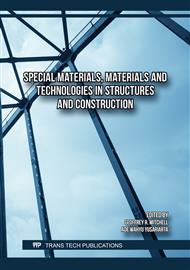p.49
p.63
p.75
p.89
p.101
p.115
p.125
p.131
p.137
The Design of KSITS Steel Modular Growing House as a Development of Local Steel Technology Downstream Industries in the Future
Abstract:
The application of modular systems is one of the new technologies worth considering. The modular system is a prefabricated steel structure where the floor decks, columns, beams, and walls are fabricated along with the utility system, mechanical-electrical, and finishing in one modular. The benefits of this system are constructability, positive aspects towards schedule, fewer on and off-site workers, quality and productivity aspects, and proper tests. A total solution is needed in the form of steel-based construction modular growing houses to support the National Development Program. Joint research is needed between Universities and Local Industries to produce technological innovations with high Domestic Component Levels in implementing the use of materials and steel manufacturing processes. The Krakatau Steel-Institut Teknologi Sepuluh Nopember (KSITS) Steel Modular Growing House Design is a steel-based construction that supports in a fast, precise, quality manner; and becomes a contributor in absorbing various locally produced steel products. From the analytical study and modeling of steel modular, the results showed that KSITS Steel Modular Growing House Design has fulfilled the requirements of structural and connection strength, serviceability control, management construction procedures, economical engineering, and manufacturing design in operational planning for the short-term and development of local steel technology downstream industries in the future. The results showed minor differences in ratios, with WF steel slightly surpassing HSS steel. HSS steel stands out due to its significantly lighter weight compared to WF steel, impacting structural dynamics and feasibility in modular house construction. This indicates that the moment capacity of HSS is lower than the moment capacity of WF. However, from the results of running, it is found that the criteria are the same, all components other than the beam, do not experience yielding prior to yielding in the beam. It means that the connection works properly according to the criteria.
Info:
Periodical:
Pages:
137-151
Citation:
Online since:
October 2025
Price:
Сopyright:
© 2025 Trans Tech Publications Ltd. All Rights Reserved
Share:
Citation:


